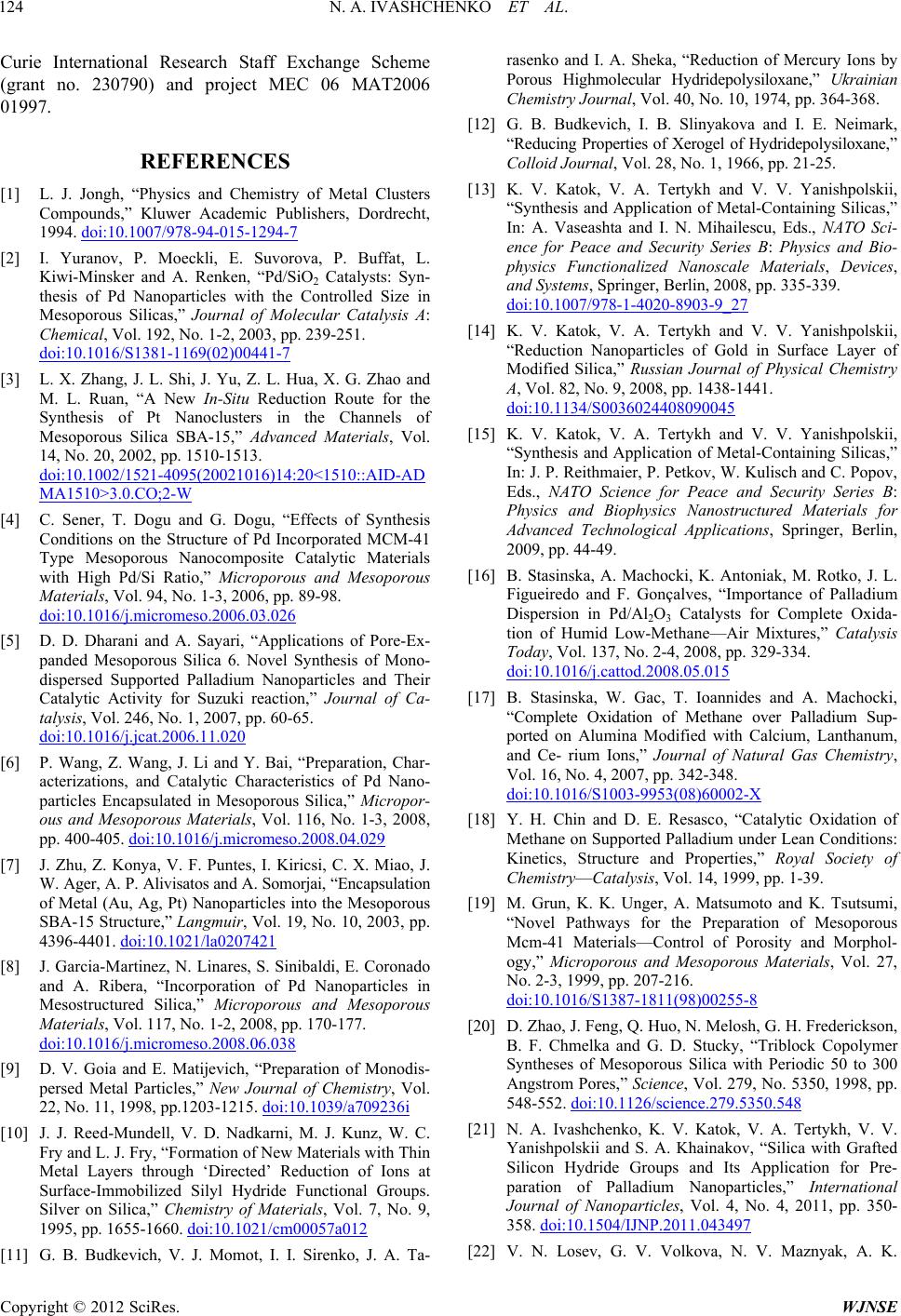
N. A. IVASHCHENKO ET AL.
124
Curie International Research Staff Exchange Scheme
(grant no. 230790) and project MEC 06 MAT2006
01997.
REFERENCES
[1] L. J. Jongh, “Physics and Chemistry of Metal Clusters
Compounds,” Kluwer Academic Publishers, Dordrecht,
1994. doi:10.1007/978-94-015-1294-7
[2] I. Yuranov, P. Moeckli, E. Suvorova, P. Buffat, L.
Kiwi-Minsker and A. Renken, “Pd/SiO2 Catalysts: Syn-
thesis of Pd Nanoparticles with the Controlled Size in
Mesoporous Silicas,” Journal of Molecular Catalysis A:
Chemical, Vol. 192, No. 1-2, 2003, pp. 239-251.
doi:10.1016/S1381-1169(02)00441-7
[3] L. X. Zhang, J. L. Shi, J. Yu, Z. L. Hua, X. G. Zhao and
M. L. Ruan, “A New In-Situ Reduction Route for the
Synthesis of Pt Nanoclusters in the Channels of
Mesoporous Silica SBA-15,” Advanced Materials, Vol.
14, No. 20, 2002, pp. 1510-1513.
doi:10.1002/1521-4095(20021016)14:20<1510::AID-AD
MA1510>3.0.CO;2-W
[4] C. Sener, T. Dogu and G. Dogu, “Effects of Synthesis
Conditions on the Structure of Pd Incorporated MCM-41
Type Mesoporous Nanocomposite Catalytic Materials
with High Pd/Si Ratio,” Microporous and Mesoporous
Materials, Vol. 94, No. 1-3, 2006, pp. 89-98.
doi:10.1016/j.micromeso.2006.03.026
[5] D. D. Dharani and A. Sayari, “Applications of Pore-Ex-
panded Mesoporous Silica 6. Novel Synthesis of Mono-
dispersed Supported Palladium Nanoparticles and Their
Catalytic Activity for Suzuki reaction,” Journal of Ca-
talysis, Vol. 246, No. 1, 2007, pp. 60-65.
doi:10.1016/j.jcat.2006.11.020
[6] P. Wang, Z. Wang, J. Li and Y. Bai, “Preparation, Char-
acterizations, and Catalytic Characteristics of Pd Nano-
particles Encapsulated in Mesoporous Silica,” Micropor-
ous and Mesoporous Materials, Vol. 116, No. 1-3, 2008,
pp. 400-405. doi:10.1016/j.micromeso.2008.04.029
[7] J. Zhu, Z. Konya, V. F. Puntes, I. Kiricsi, C. X. Miao, J.
W. Ager, A. P. Alivisatos and A. Somorjai, “Encapsulation
of Metal (Au, Ag, Pt) Nanoparticles into the Mesoporous
SBA-15 Structure,” Langmuir, Vol. 19, No. 10, 2003, pp.
4396-4401. doi:10.1021/la0207421
[8] J. Garcia-Martinez, N. Linares, S. Sinibaldi, E. Coronado
and A. Ribera, “Incorporation of Pd Nanoparticles in
Mesostructured Silica,” Microporous and Mesoporous
Materials, Vol. 117, No. 1-2, 2008, pp. 170-177.
doi:10.1016/j.micromeso.2008.06.038
[9] D. V. Goia and E. Matijevich, “Preparation of Monodis-
persed Metal Particles,” New Journal of Chemistry, Vol.
22, No. 11, 1998, pp.1203-1215. doi:10.1039/a709236i
[10] J. J. Reed-Mundell, V. D. Nadkarni, M. J. Kunz, W. C.
Fry and L. J. Fry, “Formation of New Materials with Thin
Metal Layers through ‘Directed’ Reduction of Ions at
Surface-Immobilized Silyl Hydride Functional Groups.
Silver on Silica,” Chemistry of Materials, Vol. 7, No. 9,
1995, pp. 1655-1660. doi:10.1021/cm00057a012
[11] G. B. Budkevich, V. J. Momot, I. I. Sirenko, J. A. Ta-
rasenko and I. A. Sheka, “Reduction of Mercury Ions by
Porous Highmolecular Hydridepolysiloxane,” Ukrainian
Chemistry Journal, Vol. 40, No. 10, 1974, pp. 364-368.
[12] G. B. Budkevich, I. B. Slinyakova and I. E. Neimark,
“Reducing Properties of Xerogel of Hydridepolysiloxane,”
Colloid Journal, Vol. 28, No. 1, 1966, pp. 21-25.
[13] K. V. Katok, V. A. Tertykh and V. V. Yanishpolskii,
“Synthesis and Application of Metal-Containing Silicas,”
In: A. Vaseashta and I. N. Mihailescu, Eds., NATO Sci-
ence for Peace and Security Series B: Physics and Bio-
physics Functionalized Nanoscale Materials, Devices,
and Systems, Springer, Berlin, 2008, pp. 335-339.
doi:10.1007/978-1-4020-8903-9_27
[14] K. V. Katok, V. A. Tertykh and V. V. Yanishpolskii,
“Reduction Nanoparticles of Gold in Surface Layer of
Modified Silica,” Russian Journal of Physical Chemistry
A, Vol. 82, No. 9, 2008, pp. 1438-1441.
doi:10.1134/S0036024408090045
[15] K. V. Katok, V. A. Tertykh and V. V. Yanishpolskii,
“Synthesis and Application of Metal-Containing Silicas,”
In: J. P. Reithmaier, P. Petkov, W. Kulisch and C. Popov,
Eds., NATO Science for Peace and Security Series B:
Physics and Biophysics Nanostructured Materials for
Advanced Technological Applications, Springer, Berlin,
2009, pp. 44-49.
[16] B. Stasinska, A. Machocki, K. Antoniak, M. Rotko, J. L.
Figueiredo and F. Gonçalves, “Importance of Palladium
Dispersion in Pd/Al2O3 Catalysts for Complete Oxida-
tion of Humid Low-Methane—Air Mixtures,” Catalysis
Today, Vol. 137, No. 2-4, 2008, pp. 329-334.
doi:10.1016/j.cattod.2008.05.015
[17] B. Stasinska, W. Gac, T. Ioannides and A. Machocki,
“Complete Oxidation of Methane over Palladium Sup-
ported on Alumina Modified with Calcium, Lanthanum,
and Ce- rium Ions,” Journal of Natural Gas Chemistry,
Vol. 16, No. 4, 2007, pp. 342-348.
doi:10.1016/S1003-9953(08)60002-X
[18] Y. H. Chin and D. E. Resasco, “Catalytic Oxidation of
Methane on Supported Palladium under Lean Conditions:
Kinetics, Structure and Properties,” Royal Society of
Chemistry—Catalysis, Vol. 14, 1999, pp. 1-39.
[19] M. Grun, K. K. Unger, A. Matsumoto and K. Tsutsumi,
“Novel Pathways for the Preparation of Mesoporous
Mcm-41 Materials—Control of Porosity and Morphol-
ogy,” Microporous and Mesoporous Materials, Vol. 27,
No. 2-3, 1999, pp. 207-216.
doi:10.1016/S1387-1811(98)00255-8
[20] D. Zhao, J. Feng, Q. Huo, N. Melosh, G. H. Frederickson,
B. F. Chmelka and G. D. Stucky, “Triblock Copolymer
Syntheses of Mesoporous Silica with Periodic 50 to 300
Angstrom Pores,” Science, Vol. 279, No. 5350, 1998, pp.
548-552. doi:10.1126/science.279.5350.548
[21] N. A. Ivashchenko, K. V. Katok, V. A. Tertykh, V. V.
Yanishpolskii and S. A. Khainakov, “Silica with Grafted
Silicon Hydride Groups and Its Application for Pre-
paration of Palladium Nanoparticles,” International
Journal of Nanoparticles, Vol. 4, No. 4, 2011, pp. 350-
358. doi:10.1504/IJNP.2011.043497
[22] V. N. Losev, G. V. Volkova, N. V. Maznyak, A. K.
Copyright © 2012 SciRes. WJNSE